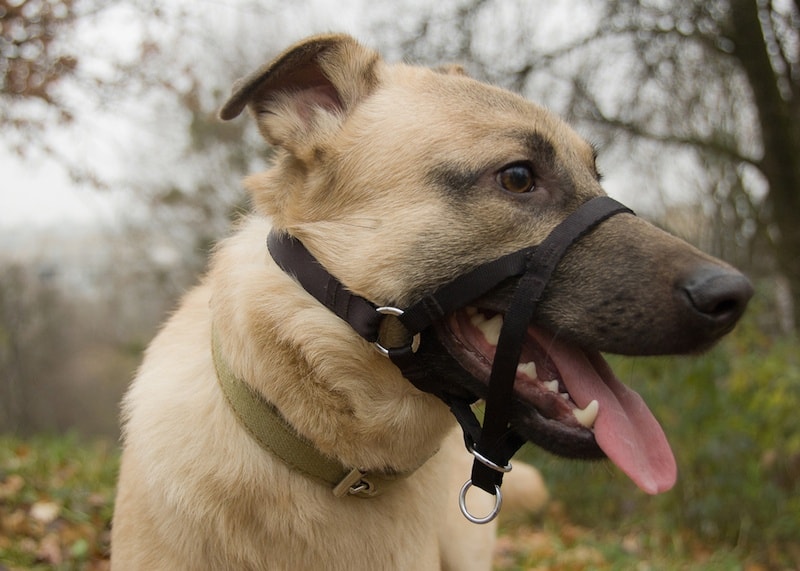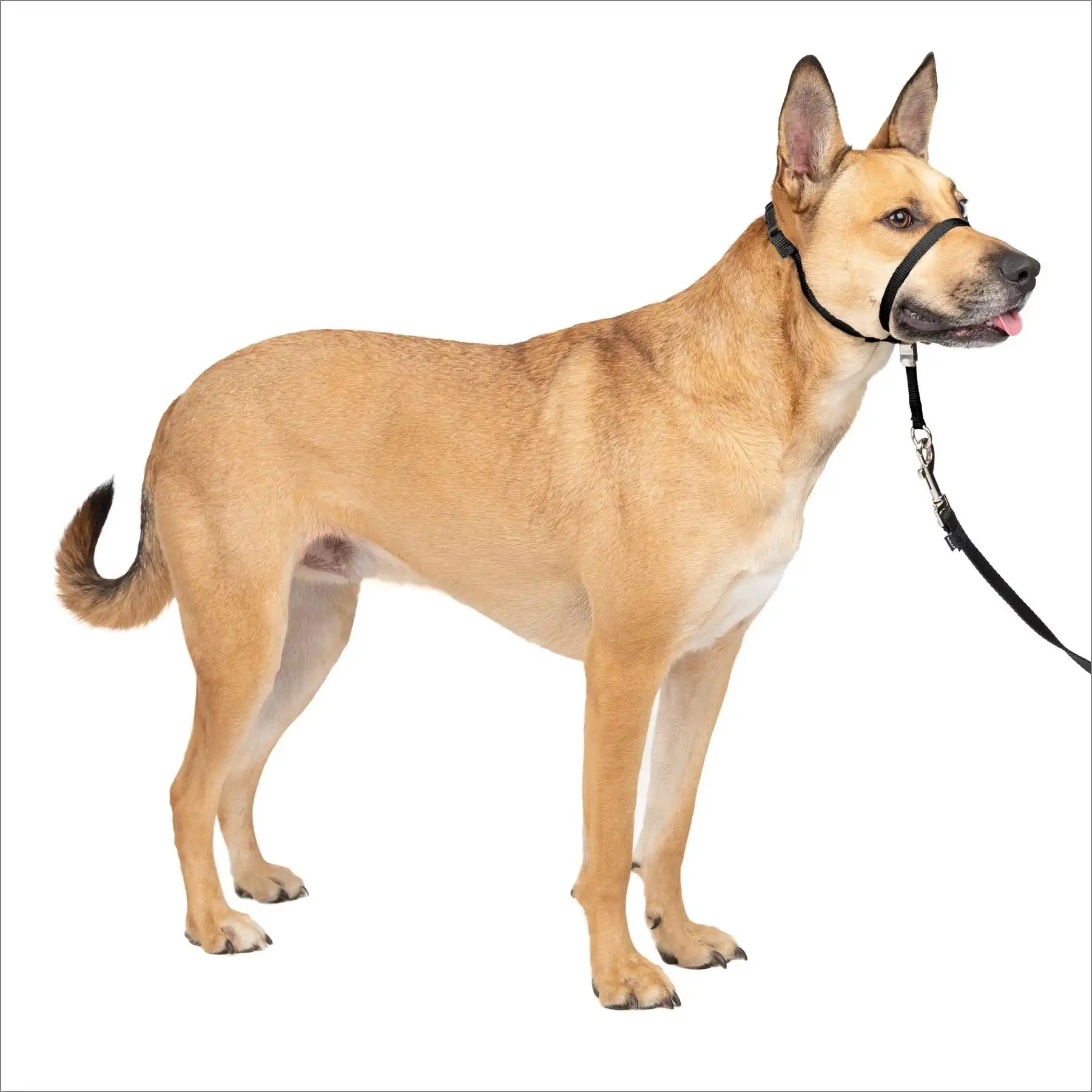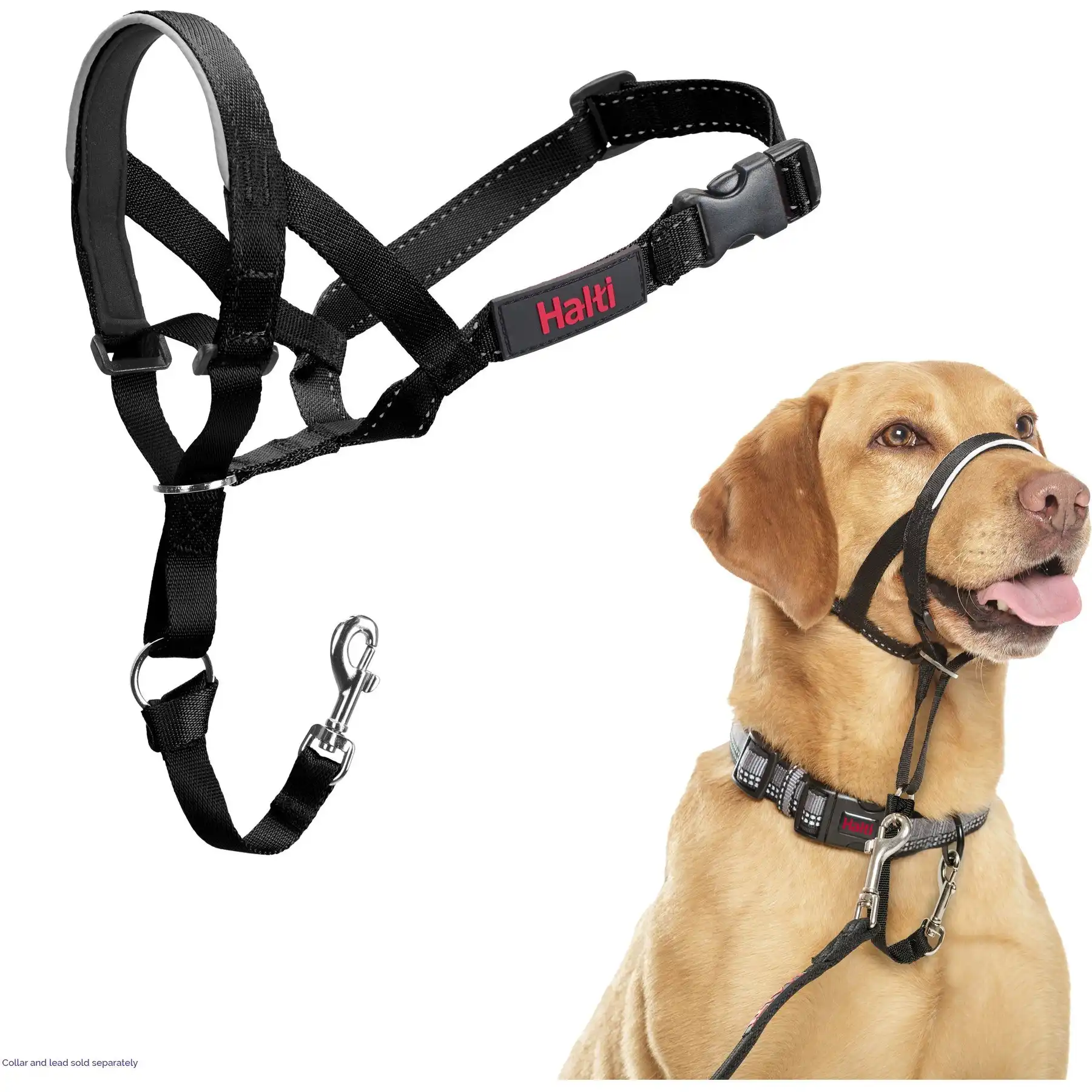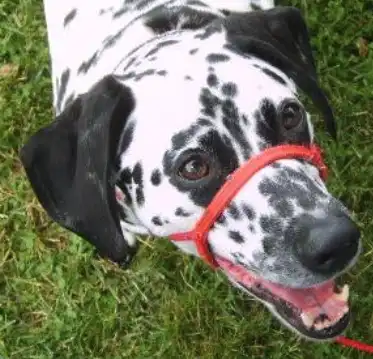If you’ve got a dog who pulls hard on the leash and can be hard to control, a dog head halter can really help you regain control on your walks.
There are several excellent brands of dog head halters out there. Today we’ll talk a bit about how to use a head halter and which are the best out there for controlling your canine.
Best Dog Head Halters: Quick Picks
What A Dog Head Halter Is (and Isn’t!)
Head halters are, more or less, a harness for your dog’s head. The idea is that a head halter can reduce pulling because while a dog can put their entire weight against their chest, they can’t put much force behind their noggin.
A dog head halter loops over your dog’s muzzle just below the eyes. You then attach your leash below your dog’s chin. When your dog pulls, the dog head halter puts pressure on the top of his muzzle, pulling his chin down or to the side.
This reduces the strength that a dog has to pull. It also gives you some control over your dog’s gaze, making it easier to redirect a reactive dog on walks.

One important note to make is that dog head halters do not teach dogs not to pull on leash. All they do is reduce your dog’s pulling power.
Some dogs find the pressure of the dog head halter on their muzzle aversive enough that they stop pulling, but others will keep on trying to pull, although with less force.
Dog head halters are a piece of equipment, like a no-pull harness, that just makes it easier to walk your dog. I vastly prefer dog head halters and no-pull harnesses over choke or prong collars. The potential for pain and damage from these first two pieces of equipment is much lower.
When I have a client whose dog won’t stop pulling on the leash, I suggest a dog head halter or a no-pull harness to help them out while they’re training the dog.
I always remind my clients that you still will have to teach your dog to walk nicely on leash, because in the vast majority of cases the dog will start to pull again as soon as you remove the piece of equipment.
We also have a full detailed video on how to teach your dog to loose leash walk, which you can check out below!
Dog Trainer’s 3 Best Dog Head Halters
There are lots of excellent dog head halters out there, but keep in mind a few factors when shopping.
Be sure to look for a head halter that has a safety strap. Dog head halters are often made of thinner material than a collar, so a backup connection is important.
A safety strap generally clips onto your dog’s normal neck collar. This ensures that you won’t lose your dog if the head halter slips off or breaks!
Other than that feature, the most important thing is fit and comfort. You might need a different size or brand of dog head halter for a pug than a Jack Russell terrier, even though the dogs wear the same size collar!
This is especially true for brachycephalic dog breeds, like Boston terriers, pugs, French bulldogs, and boxers.
1. PetSafe Gentle Leader
This vet-recommended and trainer-designed head collar features an adjustable padded nose loop for added comfort and a safety strap that clips onto your dog’s normal collar.
About: This is the dog head collar that I personally use and recommend most often. It’s relatively simple to fit and has a cushioned nose loop for optimal comfort.
Features: This classic head halter is made of two conjoining loops, one for your dog’s muzzle and one that clips around your dog’s neck. It’s worth noting, however, that the Gentle Leader is the only dog head halter on this list that lacks cheek straps to keep the muzzle loop in place.
It’s easy to find online as well as in most pet stores, since it’s sold by PetSafe.
What I Love Most: The Gentle Leader comes with a training DVD to help you teach your dog how to comfortably wear the Gentle Leader with ease!
Want to learn more about how the Gentle Leader works compared to other anti-pull harnesses? Check out our in-depth guide explaining the differences between the Gentle Leader vs Easy Walk Harness.
2. Halti Head Collar
The Halti features thicker straps and several sizes designed to accommodate dogs of various head shapes.
About: Halti’s dog head halter is very similar in design to the Gentle Leader.
The biggest difference, from what I can tell, is that Halti’s design has slightly thicker bands, which spreads pressure more evenly across your dog’s face. Sounds comfy!
Features: Like the Gentle Leader, it has a nose loop, a high-up neck collar, and a safety clip that connects to your dog’s normal collar.
What I Love Most: The Halti Headcollar is designed to be the most customizable dog head halter on the market. If you’ve got a dog with an extreme head shape (like a French bulldog or greyhound), the Halti is your best bet.
3. Snoot Loop
This head halter boasts extra security and a slip-proof design due to the multiple points of connection.
About: The Snoot Loop is the most different of the three dog head halters that I recommend. While the Halti and the Gentle Leader have almost the exact same design, the Snoot Loop is a bit more unique.
Features: Rather than being two loops joined at one place and a safety strap, the Snoot Loop has two points of connection between the loops. The muzzle loop connects to the neck collar at the base and by two cheek straps. The cheek straps really do wonders to keep the muzzle loop from slipping off your dog’s nose.
What I Love Most: The Snoot Loop is extra-secure and slip-proof from the multiple points of connection. I appreciate how the cheek straps are adjustable on the Snoot Loop, a feature that the Halti Optifit’s cheek straps lack! I also love this extra security for dogs who tend to pull really hard or escape-artist dogs. However, if you’re primarily using the Snoot Loop because your dog squirms out of standard harnesses, you might also want to consider an escape-proof dog harness instead.
Fitting and Training For A Dog Head Halter
I recommend buying your first dog head halter in person so that a knowledgeable salesperson can help you fit the halter to your dog’s muzzle. It’s important to ensure that your dog’s head halter does not rub on your dog’s head, ride up into your dog’s eyes, or slip down off of his muzzle.
A properly fitted dog head halter gives your dog plenty of space to play with a ball, pant, eat, and drink. If your dog can’t hold a ball in his mouth with his dog head halter on, it’s too tight.
Most dogs do not like the feeling of a dog head halter on their muzzles, especially at first. This video shows an excellent example of slowly teaching a dog to wear a dog head halter. I say “slow,” because the trainer moves at the dog’s pace and doesn’t put the dog head halter on the dog until the dog is ready. However, this training happened in just three five-minute sessions with the dog.
Keep in mind that it will take less time to properly train your dog to wear a dog head halter in the first place than it will take you to “fix” a dog that has had a bad experience and is scared of the dog head halter!
For those of you who would rather read instructions, here’s how to train your dog to wear a dog head halter.
Keep in mind that several five-minute training sessions will actually make your progress faster than one super-long training session!
I set timers for myself to ensure my training sessions don’t go too long. It’s ideal to end the session with both you and your dog wanting more!
Step 1: Get a properly fitting dog head halter and some mega-tasty training treats.
Step 2: Hold out the dog head halter in front of you. Say “yes,” “good boy,” or click (from now on, I’ll call this “marking” the dog’s behavior) when your dog looks at the head halter. Then feed your dog his favorite treats. Repeat until your dog’s head is ping-ponging between you and the head halter reliably.
Step 3: Hold out the dog head halter and mark when your dog moves towards it. Repeat until your dog is actually touching the dog head halter with his nose.
Step 4: Hold the dog head halter open with your hands and put a treat between the nose opening. Make sure the opening is very large, giving your dog plenty of room and comfort. Give your dog the treat when he puts his nose through the dog head halter. Repeat, very slowly moving the treat back so that your dog is reliably placing his nose further into the dog head halter.
Never force the dog head halter onto your dog’s head. This will slow your training in the long run as your dog has a negative experience with the dog head halter.
Step 5: Clip the neck collar on your dog without the nose loop on. Give some treats. Repeat. This is just getting your dog used to the very high placement of the dog head halter collar.
Step 6: Go back to step 4, but start to shrink the size of the loop. When it’s at the appropriate size, start rewarding your dog for increasingly long periods of time with his nose in the head halter. Don’t just increase the time in a linear fashion, though! Jump around a bit, so that the dog doesn’t get frustrated or overwhelmed. I recommend doing something like 1-2-1-3-2-4-1-5-2-7-3-8-1-10 in seconds as a reward schedule.
Step 7: When your dog is happily wearing the dog head halter for at least 10 seconds, start clipping on the neck collar. Keep rewarding your dog for enjoying this.
Step 8: When all of this is going well, clip on a leash. Start out with very short periods of time wearing the whole setup. Many owners go straight from their dog wearing the head halter for 10 seconds to going on a 20-minute walk. That’s a jump of 120x in duration! Many dogs also struggle with the pressure of the leash initially, so be prepared to take baby steps as you walk with the head halter at first.
Never, ever administer corrections to your dog via the head halter. This can be quite dangerous for your dog. This means that it’s unsafe to jerk on the leash or use the head halter to roughly guide your dog. You can really hurt your dog’s neck or eye if you are too rough with a dog head halter.
The Bottom Line
Dog head halters aren’t for every dog.
My border collie is so trainable that I’d much rather teach him to walk nicely on a flat collar than deal with yet another piece of dog training equipment. My closet is full enough as it is!
Some dogs are hypersensitive to something on their face, and it might be easier to teach them to walk nicely on the leash than to wear a head halter. At the same time, many of my reactive dog clients have benefitted enormously from the extra control that a dog head halter provides.
When fitted correctly and trained properly, a dog head halter is one of my favorite pieces of equipment for dealing with dogs that pull. Unlike a no-pull harness (see our top picks if you’re curious), the dog head halter requires quite a bit of training for your dog to wear it happily. That barrier to entry might be too high for some owners, but for the ones that take the time and effort, you can get some great results.

If you’re committed to training your dog properly, the dog head halter provides more safe control than any other product out there for your sled-dog-wannabe.
Have you ever used a head halter for your dog? What was your experience? Tell us in the comments!












Leave a Comment